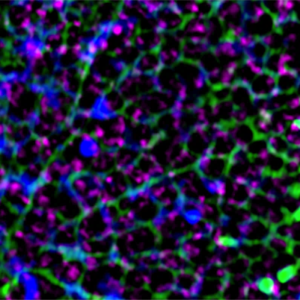
A new study published in Nature explored the architecture of nuclear lamins, fibrous proteins in a cell’s nucleus, providing fresh insights into their role in cellular function.
Using two types of microscopy, Northwestern Medicine scientists and collaborators were able to obtain the highest resolution imagery to date of the nuclear lamins’ interlaced structure. They observed the filaments are smaller and shorter then originally thought.
“It was quite a surprise; so now we think they are the smallest skeletal protein in cells,” said co-author Robert Goldman, PhD, chair of Cell and Molecular Biology and Stephen Walter Ranson Professor of Cell Biology. “We’ve had many papers over the years attempting to define the organization and structure of lamins, but this one, structurally speaking, is the most exciting because of the resolution we achieved.”
Closely related to the structural protein found in hair and skin, keratin, lamins play a role in regulating the shape and size of the nucleus. The lamins are also involved in many cellular events, including chromatin organization and regulation of gene expression.
Goldman noted these new structural observations of the lamins differentiate them in their mechanical and physical properties when compared to other skeletal elements in the cell, including actin and microtubules.
“Little has been known about their high-resolution structure, so for cell biologists, such as myself, the driving factor is structure: without structure, there is no function,” Goldman said.
Mutations in nuclear lamins can cause many rare diseases such as progeria, a premature aging disease in children, and may take part in cellular changes that occur in cancer and chronic inflammation.
“It’s a major finding and important because of the number of diseases and functions attributed to lamins,” Goldman said.
Goldman is also a professor of Medicine in the Division of Pulmonary and Critical Care and a member of the Robert H. Lurie Comprehensive Cancer Center. Other co-authors on the paper include Anne Goldman, senior research associate, and Takeshi Shimi, PhD, a research associate professor of Biochemistry and Molecular Genetics.
This work was funded by a Swiss National Science Foundation grant SNSF 31003A 159706/1, the Mäxi Foundation and GIF I-1289-412.13/2015, the Forschungskredit of the University of Zurich, National Institutes of Health grant GM106023 and the Progeria Research Foundation.





